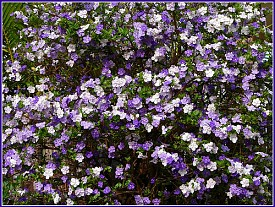Flowers, bushes, and flowering shrubs add eye appeal to any home's outdoor space. If you would like to feature ornamental plantings in your garden, you'll achieve the best results when you choose species that are suitable for the local climate and your property's own individual conditions. Not only will they tend to be healthier and better blooming, your plants will be greener in the figurative sense. They will usually need less care and feeding, and you will be contributing toward the restoration of flora native to your area.

Gardening Zone
The first step is to determine the correct gardening climate zone for your location. The USDA issues a plant hardiness zone map, which has been updated several times as new data are incorporated. However there is a limitation to the USDA map, because it indicates only the winter temperature (based on the annual average minimum) for each zone. In response, Sunset magazine has come up with a series of climate zone maps that take into account the total climate of each region, to indicate where various plant types will thrive year round.
Other Climate Factors
In addition to your location's geographic latitude, a whole host of other climate factors come into play. In windy regions, for example, hardy flowers are less likely to be uprooted by blustery weather. Higher elevations, with their strong sunlight and cool temperatures, also affect plant survival; robust flowers and bushes are best suited for these elevations. Proximity to seawater exposes plantings to salty ocean breezes. Even very local differences such as a garden's position on a hill can make a great deal of difference. Flowers and shrubs planted on the hill's side will enjoy warmer temperatures than those on either the hilltop or the valley, for instance.
Soil Quality
The quality of the soil in the microclimate of your own garden should also be taken into account when selecting plants. Different soils contain varying amounts of nutrients and pH levels. Experts recommend testing your soil every 3-4 years, as its composition can change over time. Soil testing kits are widely available through university extension services. In addition, it's helpful to determine which type of soil you have -- sandy, clay, or loamy (usually considered the ideal, as it balances good drainage with moisture and nutrient retention). If you find that it is less than perfect, you can take two actions; first, choose shrubs and plants that will flourish in your soil type and second, remediate the problem by adding organic matter.
Amount of Sun Exposure
Another important aspect of your garden's microclimate is the amount of sun it's exposed to. This will be affected by a number of conditions, some of which can be modified. To illustrate, it's possible to trim overhanging tree branches so that the flowers and bushes in your garden receive more sunshine. However, shadow from your home, other nearby structures, or geographical features is a more permanent situation. In this case, you will need to choose shade-loving plants to make your garden bloom.
Native Plants and Xeriscaping
There is a growing trend nowadays to fill home gardens -- and sometimes even to replace grass lawns -- with either native plants or xeriscaping. Native plantings preserve and restore the plants which historically are indigenous to your locale. Native plant societies all over North America work toward this conservation. Xeriscaping, on the other hand, is a kind of eco-friendly landscaping designed to reduce garden watering needs, especially for naturally dry regions. It consists of selecting plants, which may or may not be native to the area, for their low water consumption needs.





